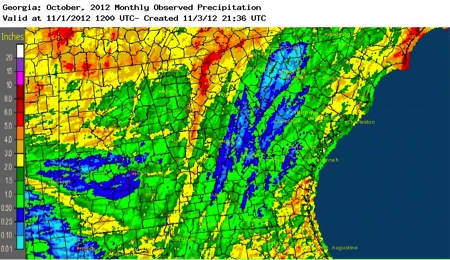Temperatures in Georgia were within one degree of normal across the state in October. Rainfall continued to be light across most of the state, continuing a trend from a dry September. A narrow band stretching from Columbus to the northeast mountains was the only area of the state that received higher than normal rainfall.
In Atlanta the average temperature for October was 63.4 degrees Fahrenheit (0.1 degrees above normal); in Athens the average was 62 degrees (1 below normal); in Columbus the average was 66.9 degrees (0.4 above normal); in Macon the average was 65.3 degrees (0.4 above normal); in Savannah the average was 68.8 degrees (0.9 above normal); in Brunswick the average was 71.1 degrees (0.9 above normal); in Alma the average was 68.9 degrees (0.5 above normal); and in Augusta the average was 64.7 degrees (0.3 above normal).
No temperature or precipitation records were set during October, but people reported scattered frost in some northern locations on Oct. 31 following the departure of clouds and winds from Hurricane Sandy.
Most of the rain in October was due to a strong low pressure coming out of the Gulf, which developed in the western Gulf of Mexico late in September. The strong moist flow from the south on the first two days of October fed into a nearly stationary band of showers and thunderstorms, causing accumulations of more than 6 inches of rain in a narrow band, but leaving most other parts of the state dry.
This rain helped raise the level of Lake Lanier, north of Atlanta, by two feet; although, it is still about 10 feet below full pool. At the end of the month, the U.S. Army Corps of Engineers announced that they would release additional water from the lake to help drought-stricken farmers in the ACF river basin, downstream in southwestern Georgia, Alabama and Florida. The lower water in the lake may increase boating hazards from stumps and sand bars.
The rest of October was drier than usual across the state, contributing to an expansion of dry conditions by the end of the month. Community Collaborative Rain, Hail and Snow Network observers in Twiggs, Mitchell and Walton counties reported that their farm ponds were dry or so low that they were bringing in additional water for their cows.
The highest monthly total precipitation from National Weather Service reporting stations was 2.98 inches in Brunswick (1.48 inches below normal) and the lowest was in Macon at 0.25 inches (2.54 inches below normal). Atlanta received 1.83 inches (1.58 below normal), Athens received 1.93 inches (1.62 below normal), Savannah received 1.15 inches (2.54 inches below normal), Columbus received 1.04 inches (1.54 below normal), Alma received 0.37 inches (2.66 below normal) and Augusta received1.36 inches (1.91 below normal).
The highest single-day of rainfall from CoCoRaHS stations was 6.3 inches near Flowery Branch in Hall County on Oct. 2. An observer west of Cleveland in White County received 6.05 inches; an observer north of Gainesville in Hall County received 5.85 inches; and an observer southwest of Sautee in White County received 5.8 inches, all on Oct. 2. Another observer northeast of Dillard in Rabun County received the highest rainfall for the month, a total of 8.78 inches. The rest of the highest monthly amounts were the same stations; all of them received more than 7 inches for the month.
Severe weather was reported on just two out of 31 days in October. Both reports were for widely scattered wind damage. However, the effects of Hurricane Sandy were felt as far south as Georgia, where many scattered power outages were observed across northern Georgia due to gusty winds and falling trees. A 2-year-old in Winder was hospitalized when he was hit in the head by a falling tree branch during the windy conditions. Snow flurries were observed in northeastern Georgia in the higher elevations.
Dry conditions in October helped farmers complete their harvests of soybeans and cotton but made the ground so hard it was difficult to dig peanuts. Farmers also complained that the lack of soil moisture was hurting pastures and delaying the planting of small grains and rye grass.
Effects of the drought in the Midwest also affected Georgia businesses. Farm equipment maker Agco Corporation in Duluth, Ga., noted that their sales were slower than expected due to a soft market caused by less need for grain storage as well as tractors. Southwest Georgia Ethanol in Pelham, Ga., temporarily closed its plant due to high corn prices and lack of available corn, most of which is shipped in from the Midwest. They may wait to open until next July, when the new corn crop comes in.








